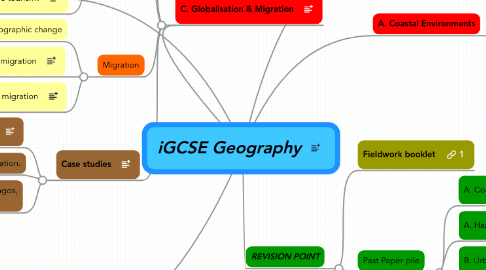
1. B. Urban Environments
1.1. Global urbanisation
1.1.1. Character of urbanisation
1.1.2. Problems of urbanisation
1.2. Urban segregation
1.2.1. Functional clustering
1.2.2. Social & Ethnic segregation
1.2.3. Shanty towns
1.2.4. Case studies
1.2.4.1. A case study of one city to show the land use patterns and the distribution of social/ethnic groups.
1.2.4.2. A case study of shanty town management in a LIC city.
1.3. Urban change
1.3.1. Edge of town
1.3.2. Inner city
1.3.3. Roles of city managers
1.3.4. Case studies
1.3.4.1. A case study of one named urban area in an HIC to explain how and why changes are taking place.
1.4. Fieldwork
1.4.1. Environmental quality survey
1.4.2. Land use transects plotting
2. B. Economic Activity & Energy
2.1. Sectors of industry
2.1.1. Classification
2.1.2. Sectorial change
2.1.3. Informal employment
2.2. Location and growth
2.2.1. Location & growth of tertiary & quaternary industry
2.2.2. Changing location of manufacturing
2.3. Rising demand for energy
2.3.1. The rising demand for energy & the energy gap
2.3.2. "Precious energy" & energy conservation
2.3.3. Renewable v. Non-renewable
2.4. Case studies
2.4.1. A comparative study of sectoral shifts in one HIC and one LIC.
2.4.2. Case study of the factors affecting the development and location of one hightech industry
2.4.3. Case study of recent employment changes within an area of a HIC.
2.5. Fieldwork
2.5.1. Investigating peoples' views on the use of renewable and nonrenewable energy
2.5.2. Reasons for the location of factories or services
3. C. Globalisation & Migration
3.1. Rise of globalisation
3.1.1. The rise of the global economy
3.1.2. Global shift in manufacturing
3.1.3. TNCs
3.2. Tourism
3.2.1. Growth of tourism
3.2.2. Impact of mass tourism
3.2.3. Sustainable tourism?
3.3. Migration
3.3.1. Linked to demographic change
3.3.2. Types of migration
3.3.3. Managing migration
3.4. Case studies
3.4.1. TNC
3.4.2. A package holiday destination.
3.4.3. Sustainable tourism (eg Galapagos, Bhutan).
4. A. Hazardous Environments
4.1. Introduction
4.1.1. Types of hazard
4.1.1.1. Climatic
4.1.1.2. Tectonic
4.1.1.3. Other
4.1.2. Distribution of hazards
4.1.2.1. Volcanic
4.1.2.2. Earthquake
4.1.2.3. TRS
4.1.3. Characteristics of hazards
4.1.3.1. Volcanic
4.1.3.2. Earthquake
4.1.3.3. TRS
4.1.4. Fieldwork
4.1.4.1. Collecting and recording weather data
4.2. Impacts
4.2.1. Short term impacts
4.2.2. Long term impacts
4.2.3. Why people continue to live in areas of hazard
4.2.4. Case study
4.2.4.1. Comparative study of two TRS - HIC & LIC impacts
4.3. Managing Hazards
4.3.1. Before the event
4.3.1.1. Prediction & Preparation
4.3.1.1.1. Shelters
4.3.1.1.2. Early warning systems
4.3.1.1.3. Education
4.3.2. After the event
4.3.2.1. Short term
4.3.2.1.1. emergency aid & disaster relief
4.3.2.2. Long term
4.3.2.2.1. risk assessment, adjustment, improving prediction
4.3.3. Case study
4.3.3.1. Managing event: Tectonic & TRS, HIC v. LIC
4.3.4. Fieldwork
4.3.4.1. Surveying peoples'views on the management of a hazard event
5. A. Coastal Environments
5.1. Physical processes
5.1.1. Processes
5.1.1.1. Marine
5.1.1.1.1. wave characteristics
5.1.1.2. Sub-aerial
5.1.1.2.1. weathering
5.1.1.2.2. mass movement
5.1.2. Landforms
5.1.2.1. Erosional
5.1.2.1.1. Lulworth, Swanage & Aldbrough
5.1.2.2. Depositional
5.1.2.3. Role of Geology
5.1.2.3.1. Aldbrough soft cliffs
5.1.2.4. Role of Vegetation
5.1.2.5. Role of People
5.1.2.6. Sea level change
5.1.2.6.1. Estuaries
5.1.2.6.2. Raised beaches
5.1.2.7. Fieldwork
5.1.2.7.1. Beach measurements, eg profiles and sediments
5.2. Ecosystems & Biodiversity
5.2.1. Distibution of coastal ecosystems
5.2.2. mangroves
5.2.3. coral reefs
5.3. Managing coasts
5.3.1. Conflict between users
5.3.1.1. agricultural practices
5.3.1.2. industrialisation;
5.3.1.3. deforestation
5.3.2. Coastal retreat & management
5.3.3. Fieldwork
5.3.3.1. Surveying peoples' views on the management of pressured and/or retreating coastlines
5.3.4. Case studies
5.3.4.1. Coral reef or Mangrove management
5.3.4.2. stretch of a coastline under pressure
5.3.4.3. stretch of retreating coastline
6. REVISION POINT
6.1. Fieldwork booklet
6.2. Past Paper pile
6.2.1. A. Coastal Environments
6.2.2. A. Hazardous Environments
6.2.3. B. Urban Environments
6.2.4. B. Economic Activity & Energy
6.2.5. C. Globalisation & Migration #1
6.2.5.1. C. Globalisation & Migration #2
